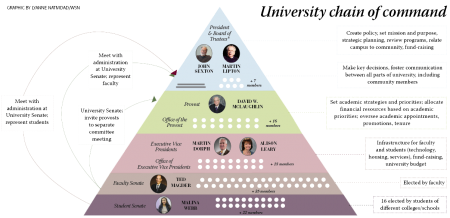Recent dissatisfaction among members of the Faculty of Arts and Science with university leadership has initiated debate over problems with transparency and communication within the tiers of governance at the university.
Since its foundation, NYU has operated under a set of bylaws that act supreme and establish the administrative structure at NYU. It enumerates the powers of all governing members in the university, from the president to the Board of Trustees and the Faculty and Student Senators Councils. It also outlines the procedures of the University Senate, the main contact point between faculty and students and the administration.
 The University Senate convenes three times per semester, and its purpose is to serve as a deliberative body and a forum for discussion of university-wide policies and changes. The four councils — Faculty Senators Council, Student Senators Council, Deans Council, Administrative Council — make recommendations to the president on university-related issues, and through him, to the Board of Trustees. According to the bylaws, the president is designated as “the official medium of communication between each faculty of the university and the Board, between university students and the Board, and between university administration and the Board.”
The University Senate convenes three times per semester, and its purpose is to serve as a deliberative body and a forum for discussion of university-wide policies and changes. The four councils — Faculty Senators Council, Student Senators Council, Deans Council, Administrative Council — make recommendations to the president on university-related issues, and through him, to the Board of Trustees. According to the bylaws, the president is designated as “the official medium of communication between each faculty of the university and the Board, between university students and the Board, and between university administration and the Board.”
Ted Magder, FSC chairperson, cites the adoption of the Principles of Shared Governance as university policy, a faculty survey of NYU 2031 and several new policies as recent examples of the system working.
“The FSC’s standing committees provide valuable input in all academic and administrative policy matters that affect the faculty,” Magder said. “This past year the FSC input into the decision-making process has been extensive and reflects the establishment of a new working relationship between the faculty and the administration.”
But faculty senator and psychology professor Jim Uleman said that the role of the FSC in establishing the Principles of Shared Governance was a 14-month struggle before it was officially accepted by the administration.
“Occasionally recommendations made by the FSC are accepted, but the recent history of this has been very mixed to poor,” Uleman said. “Most faculty view the FSC as ineffective and irrelevant, so they ignore us.”
Throughout the course of the no-confidence debate, some members of faculty have argued that there is a lack of transparency in the upper tiers of university governance.
Andrew Ross, a professor of social and cultural analysis and an active individual in the vote of no confidence debate, pointed out that although FSC and SSC minutes are made public, those of trustee meetings and administration are not.
“There is no corresponding transparency in the other two tiers of governance,” Ross said. “We have no access to the records and decision-making in the part of the administration and certainly what the trustees do is not transparent.”
NYU spokesman John Beckman said the reason the NYU Board of Trustees minutes are not made public is because they contain confidential contract negotiations and information about trustees’ views on other organizations.
“Some university boards make their minutes public but that is actually quite rare,” he said.
Magder and SSC chair Malina Webb both said the FSC and SSC have additional access to the administrative tier — the offices of the president and provost — through regular meetings outside the University Senate. Major university decisions, such as the curriculums at Global Network University sites, tuition increases, the NYU 2031 plan and the merger of NYU and the Polytechnic Institute of NYU, are discussed in these meetings. However, both chairs acknowledged a need for increased communication among the leadership and its constituents.
“The [vote of no confidence] is yet another signal that the university should commit itself to improving the channels of communication and the procedures for decision-making, a process that began in earnest last summer, a process that the FSC has been pursuing for the past year,” Magder said.
In a previous version of this article, WSN inaccurately reported that a Graduate Commission holds a vote on the University Senate. In fact, the commission does not hold a vote. WSN regrets the error.
A version of this article was published in the Monday, March 25 print edition. Veronica Carchedi is city/state editor. Email her at vcarchedi@nyunews.com.
























































































































































